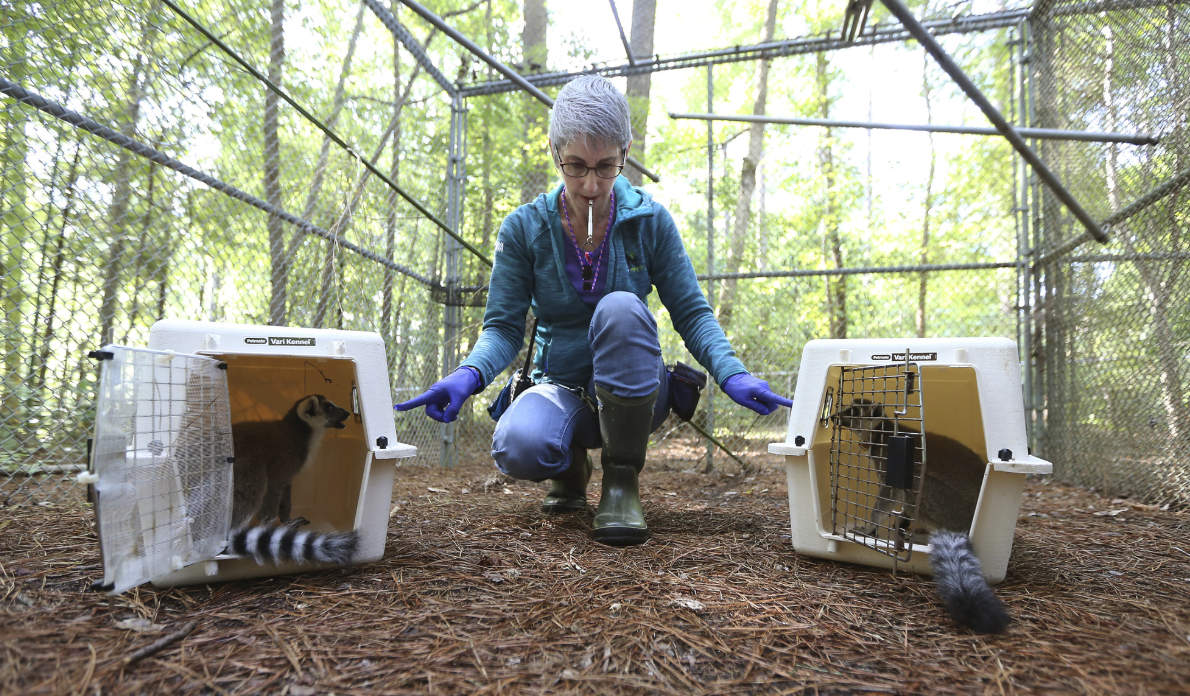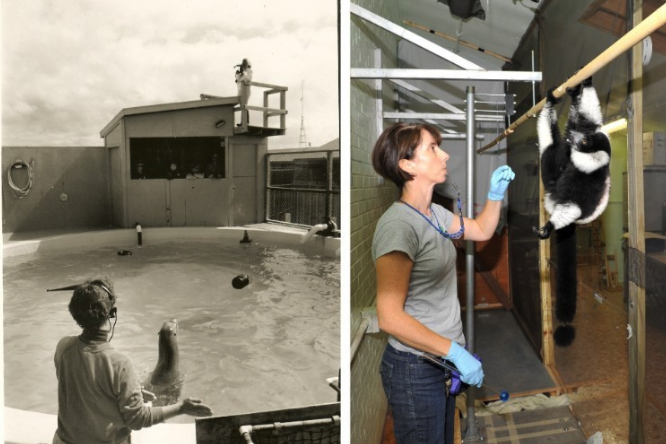One of our volunteer Technician Assistants suggested recently that we add a “Staff Spotlight” to the DLC’s monthly volunteer newsletter. We loved the idea so much that we’ve expanded it into monthly blog posts as well! Many friends of the DLC know us in passing, but may not know what led us to our careers or what we love most about working here. What a fun way for everyone to learn more about the Lemur Center’s wonderful staff!
Here, the DLC’s Curator of Behavioral Management and Welfare provides the third installment in our Staff Spotlights series.

Meg Dye uses sliced grapes and a whistle during a training session with ring-tailed lemurs Teres and Persephone.
As an undergraduate at the University of California, Santa Cruz (Go Banana Slugs! – best mascot ever!), I was extremely fortunate to work at a non-invasive research facility that was associated with the University. The Long Marine Lab (LML) was where I started as a volunteer learning how to care for dolphins, sea lions, and harbor seals. My love of volunteering had me at LML every possible minute—I would regularly run up to campus for class, in my work clothes and fish scales still on my arms, and then right back to LML.
It was at LML where I found my passion for positive reinforcement training in combination with non-invasive research. I was trained as a research assistant in a sea lion language comprehension study to explore if sea lions could successfully understand a series of nouns, adjectives, and verbs when presented in novel combinations. As I sported darkened sunglasses (to avoid cueing an animal where I was looking) and wearing a headset, the researcher would give me a sequence of nouns, adjectives, and a verb to hand signal to the sea lion, Rocky. For example, (small) + (white) + (bottle) + (retrieve). Rocky would closely watch each hand signal and then, from multiple choices floating in the water, make her object selection. Being blind to the process, I would hear in my head set if Rocky successfully completed the sequence and reinforce her with a handful of fish. The experience of that project set the foundation for my career.
Upon graduating from UCSC, I spent the next 11 years working in Chicago at the John G. Shedd Aquarium as the lead trainer for dolphins and sea otters. While at the aquarium, the combination of positive reinforcement and research continued with opportunities to work with the Navy on conditioning dolphins to participate in a hearing threshold study and working with beluga whales to monitor the design of data loggers (devices used to track migration patterns) prior to use with wild beluga populations.
Seeing an opportunity to use positive reinforcement with taxa beyond marine mammals, I ventured into the world of self-employment as a consultant with zoos and aquariums. I taught zoo keepers about the science of operant conditioning and the application of positive reinforcement with the animals in their care. I enjoyed 10 years of working as a consultant and working with an amazing array of taxa from elephants to cotton-top tamarins, and all sizes in between.
When I was hired by the DLC as their animal training consultant, I knew I had found a facility as unique and amazing as LML—just on the east coast and with lemurs! When offered the opportunity to become a permanent member of the DLC team, it took less than a heartbeat to accept. I truly love my job. I am extremely grateful to work with a dedicated and skilled staff who understand the power of positive reinforcement and the endless opportunities to combine animal training with research and animal care.

Meg early in her training career… and now, training a ruffed lemur here at the DLC!
Further resources
Our article “Playtime for Lemurs: The Value of Enrichment” offers some great background info on the DLC’s enrichment program, which Meg oversees. Training is an excellent form of enrichment! All of the DLC’s Primate Technicians complete a course with Meg, learning how to use positive reinforcement to train the lemurs to sit on a scale, enter a kennel, move to a certain spot, or other behaviors that may seem like play to the lemurs but serve a purpose if needed. The training is 100% voluntary for the lemurs. If they don’t want to participate, they don’t have to — but if they do, they get a yummy food reward like a piece of grape, craisin, or nut!
Previous Staff Spotlights
To learn more about DLC veterinarian Laura Ellsaesser, click HERE.
To learn more about DLC Director of Communications Sara Clark, click HERE.

